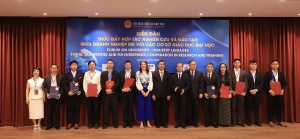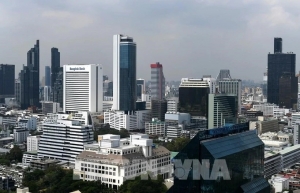New framework proposed to assess foreign-invested projects
 |
| Dr. Ngo Cong Thanh, vice chairman of the ISC and head of research team |
Why did the ISC research and propose two sets of criteria for appraising and approving foreign-invested projects?
Based on Resolution No.50-NQ/TW dated August 20, 2019 on perfecting institutions and policies, improving the quality and effectiveness of foreign investment cooperation by 2030, the National Assembly, the government, the Prime Minister and ministries and branches have issued many legal documents, including provisions regulating conditions and criteria for selecting high-quality projects. However, the criteria regulating foreign project selection are scattered in many different legal documents, so when the authorities apply the regulation in practice, it can have errors and unexpected projects.
In addition, current reports on the effectiveness of foreign-invested capital are mainly evaluated based on indicators of foreign direction investment (FDI) attraction as well as the contribution of the foreign-invested sector to the economy. There is no complete set of criteria to evaluate FDI’s effectiveness at all levels, sectors, and localities as a basis for monitoring and evaluating the effectiveness of attracting and using foreign-invested capital across the country in general and in each locality.
Based on the actual needs of localities, the ISC with financial support from the Australian Department of Foreign Affairs and Trade researched and developed two sets of criteria for FDI. These two criteria frameworks will support leaders and provincial authorities in appraising and selecting foreign-invested projects and monitoring and evaluating the quality and effectiveness of foreign-invested projects in the area.
What basis are these sets of criteria built on?
The political and legal basis for determining the criteria is Resolution No.50-NQ/TW; Resolution No.58/NQ-CP dated April, 2020 promulgating the government's Action Programme to implement Resolution 50-NQ/TW; current legal regulations on investment, land, finance, environmental protection, science - technology, national defence and security, planning, statistics.The ISC does not propose any criteria outside the current laws related to FDI.
ISC experts identified the main subjects of these criteria framework, which combine standing provincial party committee, provincial people's committee; leaders of the province's functional agencies directly related to foreign investment management (departments of Planning and Investment, Natural Resources and Environment, Science and Technology, Construction, Finance, and in collaboration with the management authorities of economic zones and industrial parks). These subjects frequently change due to rotation and appointment according to term, making it difficult to fully grasp the legal regulations related to FDI.
In addition, foreign investors looking for investment opportunities and implementing investment projects in Vietnam can also use these criteria to prepare documents to submit to competent authorities for approval.
At the end of 2022, the Vietnam Chamber of Commerce and Industry (VCCI) and the United Nations Development Program (UNDP) introduced a manual on how to use the investment screening tool to appraise projects. What is the difference between the proposed ISC assessment criteria and this screening toolkit?
To determine appraisal criteria, ISC organised a survey of localities to capture actual needs and identify the users of the criteria guidance document. The criteria are designed in the form of a reference guide so that users can easily find legal regulations related to investment projects, thus shortening the time to consider and approve the project’s investment planning to under 35 days according to regulations. We do not set too many appraisal criteria, but determine that the appraisal criteria must ensure compliance with current legal regulations, without proposing new unclear criteria.
As you know, the Ministry of Planning and Investment (MPI) submitted a draft decision on a set of criteria for evaluating the effectiveness of foreign investment in Vietnam. We also received the question whether there is a conflict between the criteria proposed by ISC and the MPI criteria.
The ISC is not a state management agency, so the set of criteria that we publish is not a legal document or executive guidance document, but is only a reference document in the management and direction process relating to foreign capital attraction.
During the process of researching and developing criteria, we discussed and asked for opinions from relevant experts at the MPI to ensure that the criteria proposed by ISC do not conflict with their criteria.
What difficulties and barriers did the ISC encounter during the process of researching and developing the two sets of criteria?
The most difficult thing is accessing state management agencies, both at the central and local levels. We had to take advantage of acquaintances to set up work schedules or have to exchange and discuss on a personal basis.
In many state management agencies, there still exists the notion that state management agencies hold the role of directing and guiding enterprises in implementation, and are responsible for drafting and promulgating important documents. They are not used to and have not accepted the fact that businesses instruct state agencies.
The practical situation also shows that it is time to innovate thinking in the direction of allowing independent research units to preside over the development of policies according to the state's orders.
How feasible are these sets of criteria?
The criteria are determined based on compliance with the provisions of the Law on Investment and relevant legal documents, derived from actual needs, combined with expert consultation.
To develop the two sets of criteria, the ISC organised a working group to work with the authorities of the provinces namely Vinh Phuc, Hai Duong, Tuyen Quang, Nghe An, and Ha Tinh and asked for comments from many other provinces and cities. ISC also organised three workshops in Hanoi and Ho Chi Minh City to seek expert opinions from ministries and localities throughout the country to complete the criteria.
Thus, we believe that the criteria are highly feasible, easy to implement, and can be quantified to rank localities when evaluating the effectiveness of foreign investment cooperation.
 | Training collaboration promoted at Vietnamese universities Foreign-invested enterprises (FIEs) and Vietnamese universities have been sharing experiences with each other to meet the demand for high-quality human resources. |
 | Enticing FDI legal framework for dual transformation Vietnam is preparing for future foreign direct investment (FDI) shifts to ensure funding reaches the right areas and embraces green and digital goals. |
 | FDI attraction in five months tops 11 billion USD More than 11.07 billion USD in foreign direct investment (FDI) was funneled into Vietnam during January-May, up 2 per cent against the same time last year, according to the Ministry of Industry and Trade (MoIT)’s Foreign Investment Agency. |
 | Thailand steps up foreign investment attraction Thailand’s National Economic and Social Development Council (NESDC) has urged the government to facilitate the country’s transition to high-tech industries to attract investors as the second largest economy in the Southeast Asia is lagging behind others in the region in terms of growth rate and foreign direct investment (FDI) attraction. |
What the stars mean:
★ Poor ★ ★ Promising ★★★ Good ★★★★ Very good ★★★★★ Exceptional
Related Contents
Latest News
More News
- Can Tho utilises its growth advantages (December 15, 2025 | 09:09)
- Ca Mau unlocking potential to shape a more sustainable future (December 15, 2025 | 09:02)
- MoF workshop highlights mounting concerns over ODA on-lending costs (December 12, 2025 | 16:05)
- National Assembly approves pilot mechanisms to accelerate major projects in Hanoi (December 12, 2025 | 11:29)
- Legislation gives government flexibility for loan guarantees (December 11, 2025 | 18:04)
- Vietnam eases policy approval requirements, simplifies foreign and outbound investments (December 11, 2025 | 17:53)
- Vietnam masters core technologies of automobile value chain (December 11, 2025 | 17:46)
- VAL opens second line of largest soybean crushing complex in Southeast Asia (December 11, 2025 | 12:08)
- Vietnam urged to shore up supply-chain resilience amid global uncertainty (December 10, 2025 | 18:47)
- Unpacking new momentum in Vietnam’s M&A market (December 10, 2025 | 09:59)

 Tag:
Tag:





















 Mobile Version
Mobile Version